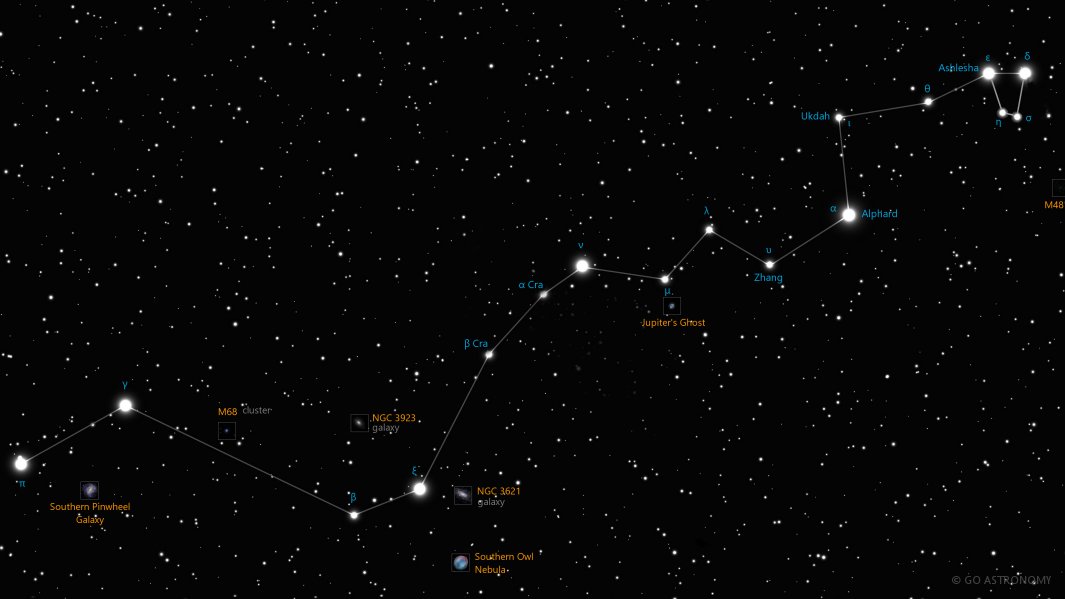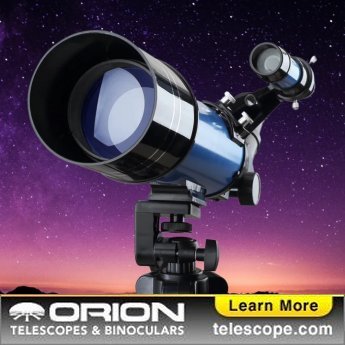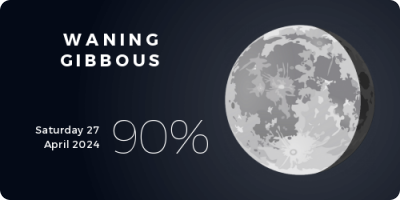Hydra, the Water Monster (Hya)
(HIGH-druh)
The Southern constellation of Hydra, the Water Monster, is best viewed in Spring during the month of April.
Hydra is the largest constellation. It's brightest star is Alphard at magnitude 1.98. The boundary of the Hydra constellation contains 23 stars that host known exoplanets.
Hydra is an equatorial constellation, which means its bulk intersects the celestial equator or comes within 10-15 degrees of doing so. Hydra is visible from most places on Earth.
WISE 0855?0714 is the 4th closest star to Earth at 7.26 light years.
- Pronunciation:
- HIGH-druh
- Meaning:
- Water Monster
- Genitive:
- Hydrae
- Abbreviation:
- Hya
- Constellation Family:
- Hercules
- Hemisphere:
- Southern
- Quadrant:
- SQ2
- Visibility:
- 54° N - 83° S
- Best viewing month*:
- April
- Area:
- 1303 sq. degrees
- Equatorial:
- Yes
- Right Ascension (avg):
- 9h 8m
- Declination (avg):
- -17°
- Brightest star:
- Alphard (1.98)
- Stars with planets:
- 23
Brightest Stars in Hydra
The 10 brightest stars in the constellation Hydra by magnitude.
- Star
- Magnitude
- Spectral class
- Alpha Hydrae (α Hya)
- 1.99
- K3III
- Gamma Hydrae (γ Hya)
- 2.99
- G8III
- Zeta Hydrae (ζ Hya)
- 3.11
- G8III-IV
- Nu Hydrae (ν Hya)
- 3.11
- K0/K1III
- Pi Hydrae (π Hya)
- 3.25
- K2III
- Epsilon Hydrae (ε Hya)
- 3.38
- G0III-IV
- Xi Hydrae (ξ Hya)
- 3.54
- G8III
- Lambda Hydrae (λ Hya)
- 3.61
- K0III
- Mu Hydrae (μ Hya)
- 3.83
- K4III
- Theta Hydrae (θ Hya)
- 3.89
- B9.5V
Double Stars in hydra
These are the brightest and easiest-to-find double, triple, and quadruple star systems in the constellation hydra. Also see all star clusters.
- Star system
- Magnitudes
- Type
- N hydrae
- 5.6, 5.7
- double
Star Clusters in Hydra
The most notable and easy-to-find star clusters in the constellation Hydra . Also see all star clusters.
Nebulae in Hydra
Notable and easy-to-find nebulae in the constellation Hydra . Also see all nebulae.
Galaxies in Hydra
The most notable galaxies in the constellation Hydra . Also see all galaxies.
- Name
- Alt name
- Type
- Hydra A Cluster
- galaxy group
- Southern Pinwheel Galaxy
- M83
- spiral
- Arp 142
- galaxy pair
- NGC 3081
- ring
- NGC 3109
- spiral
- NGC 3314A/B
- galaxy pair
- Peekaboo Galaxy
- irregular
Milky Way Satellites in Hydra
Dwarf satellite galaxies that orbit the Milky Way Galaxy located in the constellation Hydra. Also see all Milky Way satellite galaxies.
- Galaxy name
- Alt name
- Magnitude
- Hydra II
Neutron Stars in Hydra
These are the most well-known neutron stars in the constellation Hydra. Although neutron stars cannot be seen in any amateur telescope, they are at the center of many supernova remnant nebulae, which can be seen. Also see all neutron stars.
The Water Monster Constellation
Hydra, named after the mythological water snake, is the largest constellation in terms of area covered and stretches for more than 100 degrees across the sky. Known for its considerable size, historical significance, and for hosting an array of celestial objects, Hydra offers astronomers and star enthusiasts a wide range of areas to explore.
Historical Overview
Hydra's roots can be traced back to ancient times. It's one of Ptolemy's 48 constellations, named after the Lernaean Hydra, a many-headed water monster from Greek mythology. This creature was slain by Heracles (Hercules) as one of his twelve labors. The constellation was cataloged in the 2nd century by the Greek astronomer Ptolemy.
Location and Main Features
Hydra is located in the second quadrant of the southern hemisphere (SQ2) and can be seen at latitudes between +54? and -83?. Given its sprawling size, it's bordered by numerous constellations, including Cancer, Canis Minor, Centaurus, Corvus, Crater, Leo, Libra, Lupus, Monoceros, Puppis, Pyxis, Sextans, and Virgo.
Major Stars
Hydra's most prominent star, Alphard (Alpha Hydrae), is a solitary, bright star with an apparent magnitude of 2.0, making it a second-magnitude star. Alphard, which means 'the solitary one' in Arabic, is a giant orange star, situated about 177 light-years from Earth.
Other significant stars in Hydra include Gamma Hydrae, a yellow giant around 132 light-years away, and Epsilon Hydrae, a multiple star system about 135 light-years distant. Hydra also hosts Zeta Hydrae, an orange giant star around 167 light years from Earth, and several other binary and variable stars of note.
Deep Sky Objects
Due to its considerable size, Hydra encompasses many deep-sky objects, including several galaxies and a ghostly planetary nebula. One of the best-known galaxies is the Southern Pinwheel Galaxy (Messier 83), a barred spiral galaxy that is one of the closest and brightest barred spiral galaxies in the sky, and one of the most observable from Earth's southern hemisphere.
Another notable object is the Hydra Cluster (Abell 1060), one of the nearest galaxy clusters to the Milky Way, containing 157 bright galaxies. The Ghost of Jupiter (NGC 3242), a planetary nebula appearing somewhat similar to the planet Jupiter, is also found in Hydra.
Observation
Due to its sprawling size, different parts of Hydra reach their highest point in the sky, or culmination, at different times. For observers at mid-northern latitudes, the head of Hydra culminates in the evening sky in December, while the tail attains its highest point in April. While some parts of Hydra are observable in many parts of the world, its southernmost regions are best viewed from the southern hemisphere.
* Constellation shown for northen hemisphere skies. For the southern hemisphere, constellations appear rotated 180 degrees (upside-down and left-right reversed) from what is shown. Remember that seasons are reversed too - summer in northern latitudes is winter in southern latitudes.
** Circumpolar constellations are visible year-round in the hemisphere listed (and not at all in the opposite hemisphere).





